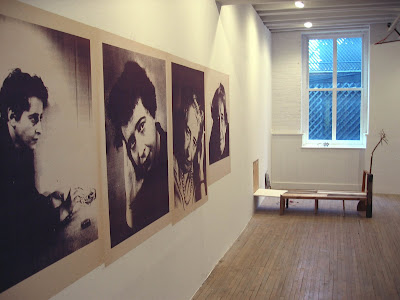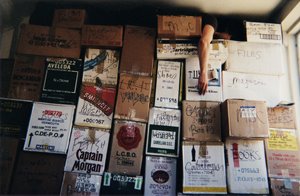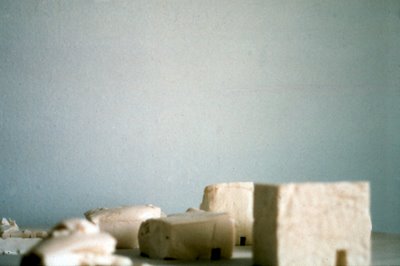2.12.08
28.8.07

4835 Prince Edward Street (2007)
Bond paper, thread, various garden implements.
A maquette was installed in the front yard of the Walshe house, shown here with Adam Brickell sitting beneath it. The installation operated as performance, party game (played by mathematicians) and neighborhood curiousity.
This is a study for a larger piece to be suspended in three sites: home, forest, gallery.
Click on the image for a clearer view.
15.7.07


 If 6 were 9 (2007)
If 6 were 9 (2007)Store bought mirror balls, aircraft cable, vinyl
"A model of Saturn hovers on its axis with an air of science fair amiability. In an age of technological dexterity and simulation, there is something readily accessible about this human-scaled heavenly body, constructed from disco ball and vinyl. The familiarity of the material opens up a multivalent associative field in which the viewer can pleasure. In the dust of the afternoon, however, mirror balls and vinyl tend to conjure memories of bygone fun. A slight touch anywhere along the planet's axis will cause it to sway. Perhaps this is why Thorne's rendition of the "sad planet" evokes amusement and regret. This captivating object might lure the viewer into a temporary reverie, but it soon prompts thought on the notions of balance, tension, and suspension. Thorne's model is part of a larger project to represent Kepler's solar system – reflecting the light between individuals and systemic consequences." Tusa Shea, University of Victoria
The two top images are from Street Scene an exhibition at Murray Guy (NY) curated by Lee Plested, the photographs also feature work by Luis Jacob and Lucy Pullen. After mounting Saturn - Jupiter, Mars, Earth, Venus and Mercury were installed by gallerists Janice Guy and Margaret Murray over the duration of the show, as if we were travelling through space, with the date of installation synonymous with the date of landing.
11.5.07

State of Emergency (2007)
Blue tarp, orange surveyor twine, rare earth magnets. Dimensions variable.
The icosahedron, a twenty sided platonic solid is frozen in space. Each triangle of blue tarp is held in tension by three pieces of fluorescent orange surveyor twine. The twine is fixed to the architecture with rare earth magnets. 60 points of contact — on the floor, the walls and the ceiling — create an agreement in the middle of the room. That individual facets come together to produce a simple shape is the result of delicate negotiations.
19.3.07
Singularity
(2006)
A scientific imagination has described the effect of looking out of the black hole: time is transfigured such that all geological history is visible, between breaths one could witness himalayas erode into the sea. This evocation of swift global change is an invitation to contemplate our role in the required massive human response.
“The artists in the exhibition use formal elements not to appeal to the individuality of subjects, but to establish a common ground. Kika Thorne’s Singularity, 2006 clearly sets up such a ground. The two pink and black suspended spandex planes held in unison give form to an abstract idea, the idea of the black hole. She responds aesthetically to an idea of something that is speculative that is believed to exist, but only has an imagined form. The black hole is a theoretical description of a total gravitational collapse of a giant star or a group of stars. The centre is thought to contain so much matter in such a small space that light cannot even move through it or escape from it. The density is known as a singularity and it is this imagined space where Thorne situates her scheme. The form is very simple; using the basic physics of a parabola, Thorne draws a diagram for a discussion space where ideas, no matter how impossible to materialize, are physically caught. The singularity becomes a place where Thorne responds to the form with a specific situation, positing her own singular idea and imagining it as space where others can posit theirs.
But ultimately, Singularity maintains its status as a form that is part of a larger phenomenological practice that exists as a sensory experience where viewers can enter collectively. The subjective position isn’t denied, but is only possible after the idea is presented as a form — as an abstraction of an abstraction." — Jenifer Papararo, Gasoline Rainbows, CAG, Vancouver:
(2006)
A scientific imagination has described the effect of looking out of the black hole: time is transfigured such that all geological history is visible, between breaths one could witness himalayas erode into the sea. This evocation of swift global change is an invitation to contemplate our role in the required massive human response.
“The artists in the exhibition use formal elements not to appeal to the individuality of subjects, but to establish a common ground. Kika Thorne’s Singularity, 2006 clearly sets up such a ground. The two pink and black suspended spandex planes held in unison give form to an abstract idea, the idea of the black hole. She responds aesthetically to an idea of something that is speculative that is believed to exist, but only has an imagined form. The black hole is a theoretical description of a total gravitational collapse of a giant star or a group of stars. The centre is thought to contain so much matter in such a small space that light cannot even move through it or escape from it. The density is known as a singularity and it is this imagined space where Thorne situates her scheme. The form is very simple; using the basic physics of a parabola, Thorne draws a diagram for a discussion space where ideas, no matter how impossible to materialize, are physically caught. The singularity becomes a place where Thorne responds to the form with a specific situation, positing her own singular idea and imagining it as space where others can posit theirs.
But ultimately, Singularity maintains its status as a form that is part of a larger phenomenological practice that exists as a sensory experience where viewers can enter collectively. The subjective position isn’t denied, but is only possible after the idea is presented as a form — as an abstraction of an abstraction." — Jenifer Papararo, Gasoline Rainbows, CAG, Vancouver:

 The Architecture of Thought
The Architecture of Thoughttools for a radical cartography
(2005)
The Architecture of Thought transforms theoretical models into architectural models.
For this current iteration of The Architecture of Thought :: tools for a radical cartography; 3 models sketch a political cartography seen through the lens of western philosophy,: Louis Althusser’s “Ideology and Ideological State Apparatuses: Notes Towards an Investigation;” Gilles Deleuze and Felix Guattari’s “Introduction: The Rhizome”, from A Thousand Plateaus; and Plato’s “Republic”, translated by Paul Shorey, from Plato Collected Dialogues.




C-SIDE
Firgrove Community Redesign (2004)
C-SIDE COLLECTIVE: Josephine Akyeampong, Adrian Blackwell, Sebastiao Dinguana-Sivuilu, Keriann Fraser, Kofi Frempong, Lisa Hassan, Clairandean Humphrey, Colanthony Humphrey, Lashai Mingo, Ashley Nkrumah, Francis Nkrumah, Kyle Montague, Skye Sepp, Kizzy-Ann Taylor, Kika Thorne, Fatma Yasin, Shadya Yasin. Commissioned by AGO Teen Council, Metro-Ago-Go, Art Gallery of Ontario, 2004
After touring the neighborhood, taking photos and sharing stories: using a 8 foot x 12 foot aerial photo of the Jane Finch neighbourhood, the C-SIDE Collective (specifically residents between ages 8 and 16) placed cyan and red dots to indicate personal and collective responses to existing public space. We numbered the photographs, found their location on the aerial, then created a list of proposals for the neighborhood.
The map expands on these propositions.
Health + recreation: Bigger playground, bigger Rec Centre, with more rooms to separate programmes. We need a jungle gym, indoor gym with a real basketball court (no concrete floor!), pool renovations to the existing outdoor pool, an Olympic size indoor pool, baseball field. Sports injuries clinic.
Knowledge production: Kids library, employment services, media production lab, audio recording studio. Public art, more art expression in the communities, graffiti murals, sculpture.
Landscape + lighting: Better sidewalk, plant more trees, greenhouse, urban farm, create landscape to link the neighborhoods to each other and to the ravine. Pedestrian bridges to cross Jane St. Take down cameras, the trees were cut down to put up surveillance cameras. There is too much police presence, we want a safer area, we need a light system. Less police, more lights.
Building + waste management: Increase scale of new building. More townhouses and apartments with spacious rooms, more washrooms, add windows to each bathroom. Non-commercial space to eat and hang-out. Progressive waste management, recycling, composting: more garbage cans, different placement, stairwell cleanup.
Commercial: Closer stores, weekly organic farmers market and homemade goods exchange. Create a street life with retail on Jane Street.
 Subway Transfer
Subway Transfer(2004)
Kika Thorne
White vinyl lettering, TTC platforms across GTA,
An Open Source City project commissioned by Kathleen Pirrie Adams, Amanda Ramos, InterAccess + Artcity. Research by Tom Strickland + Emily Hogg, documentation by Adrian Blackwell, text edits with Amish Morrell. Public exhibition in the storefront of Toronto Free Gallery 9' x 12' Fall 2004
Open Source City: Amanda Ramos and Kathleen Pirrie Adams commisioned 4 artists to test civic emotional receptivity. In fall of 2003, I was invited by Artcity curator Tom Strickland to make an artwork for the Calgary LRT. I proposed to place multiple language directions on the LRT platforms. Using City of Calgary Statistics, backed up by community workers at LINC and CCIS, I chose the languages of recent refugees, non-status and migrant workers: Chinese, Russian, Tagalog, Punjab, Farsi and Urdu. (These languages are fairly constant across the major metropolitan areas of Canada). On the day of installation, the Calgary Transit Authority pulled their approval for the project, citing the spectre of bad press. After abundant community dialogue, I brought the white vinyl back to my home town and placed it in the TTC, quietly, over a period of 4 months. Documentation of the intervention was inserted into a vinyl transfer of the TTC map (9’ x 12’) in the front window of the Toronto Free Gallery, Fall 2004.
 Collective Subway Sandwich
Collective Subway SandwichCollective: Katie Bethune-Leamen, Patrick Borjal, Permjit Buadhwal, Sam Cartmell, Janice Demkiw, Kevin Hegge, Luis Jacob, Kelly Jazvac, Paul Lamothe, Jeremy Laing, Amish Morrell, Will Munroe, Sandy Plotnikoff, HR, Mohammed Shanti, Catherine Stinson, Chen Tamir, Kika Thorne, Izida Zorde. December 2003
Video by Kika Thorne
A (post) fordist collective model for constructing a sandwich on the TTC. We assembled at Bathurst Station in downtown Toronto, boarded the Bloor-Danforth train heading eastbound towards the suburb of Scarborough. At Kennedy Station we proceeded to form a sandwich-making assembly circle. The first person brought out bread, passed the bread to the next person, who added one ingredient. As it was passed from person to person in this way, the sandwich was gradually built until -- filled with 19 ingredients -- it reached the end of the assembly line. In a mood of celebration, the vegetarian sandwiches were enjoyed by the collective and offered to other passengers. This process was continued as we traversed the city to the end of the line, Kipling Station, in Etobicoke.
 Ambience of a future city
Ambience of a future cityKika Thorne + Adrian Blackwell
3 Posters 36" x 48" and 3 CD's 2hrs each, 2001
We asked groups critical of capitalist urban development to participate in a design discussion. Each group chose a specific site in the City of Toronto. They imagined their needs realized in built form. We took their ideas and represented them in a single poster The poster was placed in public view of the location they desired to change. This document was made in collaboration with Bread not Circuses. Sound mastering by Allan Graham, design support by Dan Young. The two other posters were made in collaboration with Catch Da Flava (Regents Park) and Random Anarchist Group (Kensington).
18.3.07

 Work Labour Action
Work Labour ActionKika Thorne, 1999 -ongoing
5 3’x 4’ posters randomly wheat-pasted around the city
Work Labour Action is a five photo poster narrative from the life of Hannah Arendt. Each image is taken during the period in which she was writing a seminal text: The Loves of St. Augustine (1924); The Origins of Totalitarianism (1951); The Human Condition (1958); Eichmann in Jerusalem: A Report on the Banality of Evil (1963), On Revolution (1963); The Life of The Mind: Willing, Thinking (1977). Work represents the work of art, the thing that is left behind, Labour is the maintenance, the task of postering for instance, Action is the political speech enacted in the public sphere.
(Top) Street Scene, an group show curated by Lee Plested at Murray Guy in Chelsea, New York. The 5 bluelines are crudely wheat-pasted to the gallery walls. Gareth Moore's work is the background.
(Below) This site is at the corner of Euclid and Queen on a TD Canada Trust, Toronto.


 WORK
WORKDirected by Kika Thorne. Starring Shary Boyle. Music by Peaches.
11 minutes colour digital video 1999
10 scenes, a minute each, this splitscreen video is a day in the life of an artist and the work she does to make the work she loves. 2 cameras, long static takes. Each double-shot is set according to architectural constraints. Non actors invent their lines. There is no character definition. just a personal response to the predefined subject matter, people, location, moment. Peaches composed the beats in her bedroom watching the fine cut.
 Fabricator T-shirt Exchange
Fabricator T-shirt Exchange176 t-shirts printed for the event, each with photo silkscreened instructions on how to take off a t-shirt and exchange it for another. People brought their own shirts to exhange; the trading lasted into the night. Power Plant, Toronto, 1998.
Project by Fabricator. Fabricator is Adrian Blackwell, Cecelia Chen, Barry Isenor, Marie-Paule Macdonald, Christie Pearson, Kika Thorne.
1:1 over 1:300
Kika Thorne + Adrian Blackwell
floor projection 10’ x 15’, 160 slides, 10 min, 1998
You enter a darkened room; a slide projection covers the floor from wall to wall. The first images are of a sunlit maple floor. Ghosted figures carry sheets of aerial photographs into the space until they cover the entire floor. A railway cuts the map on the diagonal, separating residential from industrial, in a downtown Toronto neighbourhood in which we both live. As you look around the room, boxes appear; the inhabitants unpack, making a home in the city. Urban planning is enacted according to the exigency of domestic events. Dinner is made night comes, day breaks: the rhythm of three days punctuated by work, leisure, love, band practice, friends.

Kika Thorne + Adrian Blackwell
floor projection 10’ x 15’, 160 slides, 10 min, 1998
You enter a darkened room; a slide projection covers the floor from wall to wall. The first images are of a sunlit maple floor. Ghosted figures carry sheets of aerial photographs into the space until they cover the entire floor. A railway cuts the map on the diagonal, separating residential from industrial, in a downtown Toronto neighbourhood in which we both live. As you look around the room, boxes appear; the inhabitants unpack, making a home in the city. Urban planning is enacted according to the exigency of domestic events. Dinner is made night comes, day breaks: the rhythm of three days punctuated by work, leisure, love, band practice, friends.

 Monument for Sean Keagan
Monument for Sean Keaganproject by April Group
The Ontario Coalition Against Poverty, aka OCAP, asked several artist teams to produce monuments to people who had died in or around Allan Gardens, an important refuge in the City of Toronto for homeless people. Sean Keagan was a young trans prostitute murdered by their john. Our monument is made of sod, cut out of the ground and rolled back to evoke a bed, a grave, a sleeping bag.
The April Group was Adrian Blackwell, Cecelia Chen, Christie Pearson and Kika Thorne, 1997
 Mattress Plaza
Mattress Plaza Project by February Group
On March 1 + 2nd of 1997, a group of architects and artists lay down their beds in the public square to protest the homelessness and possible migration the Tory government has enforced through amalgamation, service cuts, tax hikes...
The February Group is Adrian Blackwell, Cecelia Chen, Luis Jacob, Christie Pearson, Kika Thorne and everyone who make the event come alive.
Mattress City
film by Kika Thorne and Adrian Blackwell
8 minutes S8 to Beta colour + b/w 1998
distributed by Vtape
 Inflatable Tunnel
Inflatable TunnelProject by the October Group. October 1996
During the Metro Days of Action, 150' long building was inflated using the air vents in front of Toronto’s Nathan Phillips Square. The October Group action references both public institution and temporary home to protest the erosion of the city.
The October Group is Adrian Blackwell, Cecelia Chen, Daniel Diaz Orozco, Kenneth Hayes, Barry Isenor, Mike Lawrence, Christie Pearson, Kika Thorne, Weibke von Carolsfeld, Derek Wang.
October 25th + 26th, 1996
Film by Kika Thorne. 8 minutes b/w S8 to Beta video 1996 distributed by Vtape + CFMDC
Photo by Kelly O'Brien






